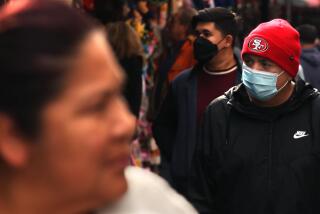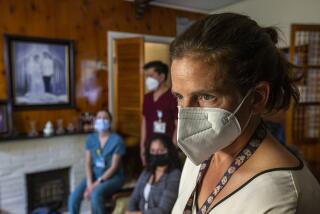More counties removed from California’s COVID-19 watchlist
- Share via
Gov. Gavin Newsom said Monday more counties came off California’s COVID-19 watchlist over the weekend after posting declines in cases, transmission rates and hospitalizations for three consecutive days and that guidance was expected to be released this week.
- Share via
More counties came off California’s COVID-19 watchlist over the weekend after posting declines in cases, transmission rates and hospitalizations for three consecutive days.
Orange, Mono and Sierra counties were removed from the list after meeting six safety thresholds that state officials established to measure the spread of the virus, as well as hospitalizations and capacity in hospitals’ intensive care units.
Being placed on the list forces counties to close various types of indoor activities, but being removed from it does not immediately allow the three counties to open up more widely. Indoor operations at nail salons, barbershops and fitness centers, among other businesses, must remain closed until the state’s top health officer revises the order that spells out the rules for the watchlist.
For the last few weeks, state health officials have been promising to release updated guidelines for the watchlist following the discovery of a technical glitch in the state’s database of test results that prompted officials to suspend the use of the list.
Gov. Gavin Newsom said Monday that guidance was expected to be released this week.
Removal from the list does give a county the ability to reopen schools for in-person learning. If a county remains off the monitoring list for 14 days in a row, schools teaching any grade level would have the green light to reopen. No county has met that bar, in part because the watchlist was frozen after the glitch.
Sierra County was most recently added to the list, on Aug. 17, whereas Orange and Mono counties have been on it for more than a month. While the watchlist was frozen, local officials in both counties expressed frustration with a lack of communication from the state about the timing and requirements for removal from the monitoring chart.
“The issue for us and perhaps many counties is how to get off the list when the metrics are below the state thresholds for the required 14 days,” Mammoth Lakes public information officer Stuart Brown said in mid-August. “We have been unable to get any clarification from the state, and [it’s] even harder now with Dr. Sonia Angell’s departure.”
Angell, Newsom’s director of the California Department of Public Health, resigned Aug. 9, days after the state revealed problems with its database. State epidemiologist Erica Pan took over as the acting health officer following the resignation.
Thirty-five counties currently are on the state’s watchlist, Newsom announced at a news conference Monday. At least one — Amador — is slated for removal as early as Tuesday. To be removed from the list, a county must show that fewer than 100 people per 100,000 have tested positive for the virus, the rate at which people test positive for the virus is below 8%, and the number of people hospitalized has not climbed more than 10% over a three-day period. In addition, more than 20% of intensive care beds in hospitals and 25% of ventilators have to be available.
“We are seeing a decline in the overall monitoring list,” Newsom said, stressing that progress made in populous areas such as San Diego County, which was removed from the list last week, and Orange County is particularly noteworthy.
Last week, Newsom said San Francisco County was expected to come off the list soon. But a week later, the county remains on the list for COVID-19 infections, hospitalizations and hospital capacity that exceed the state’s required metrics.
Some counties, including Santa Clara, reduced their virus counts enough to be removed from the state watchlist, only to be added back when their numbers climbed again.
Los Angeles County remains on the state’s watchlist for a case count that exceeds 200 infections per 100,000 people. Last week, Los Angeles County’s chief medical officer said new coronavirus cases might drop below 200, the minimum at which officials can apply for waivers to reopen elementary schools.
During a news briefing Monday, Los Angeles County’s health officer, Dr. Muntu Davis, reported 13 additional coronavirus-related deaths and 1,198 more cases in the county. Davis emphasized the need for residents to maintain social distancing practices and avoid gatherings outside of individual households — behaviors that have contributed to the overall decline in daily cases, hospitalizations and deaths the county has seen in recent weeks.
Daily hospitalizations decreased by 45% from a peak of more than 2,200 in mid-July, according to data released by the county Monday. Officials also reported that while the county saw about 3,200 new cases per day in mid- to late July, as of Aug. 22 there has been a weekly average of 1,400 daily new cases.
“If we can maintain this lower transmission, it means we could begin to think about schools reopening,” Davis said.
Asked whether officials are concerned that the county could see a sharp surge in cases after the approaching Labor Day weekend, as happened following Memorial Day and the Fourth of July, Davis said health officials are engaging in discussions with city mayors about steps that may need to be taken to prevent another post-holiday jump in infections.
“It’s always a concern if people are going to be around others who are not part of their household,” he said.
More to Read
Sign up for Essential California
The most important California stories and recommendations in your inbox every morning.
You may occasionally receive promotional content from the Los Angeles Times.












